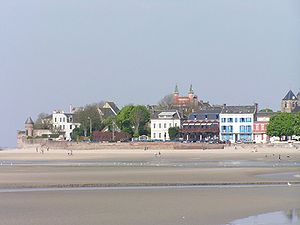Le Crotoy
|
Le Crotoy L'Crotoé |
||
|---|---|---|

|
|
|
| region | Hauts-de-France | |
| Department | Somme | |
| Arrondissement | Abbeville | |
| Canton | Rue | |
| Community association | Ponthieu-Marquenterre | |
| Coordinates | 50 ° 13 ′ N , 1 ° 38 ′ E | |
| height | 2-14 m | |
| surface | 16.32 km 2 | |
| Residents | 2,012 (January 1, 2017) | |
| Population density | 123 inhabitants / km 2 | |
| Post Code | 80550 | |
| INSEE code | 80228 | |
 Le Crotoy at low tide |
||
Le Crotoy is a French commune with 2,012 inhabitants (at January 1, 2017) in the department of Somme in the region of Hauts-de-France . It belongs to the Arrondissement Abbeville and the canton of Rue .
geography
The municipality is located on the northern bank of the mouth of the Somme River , which is not quite correctly called Somme Bay , and is around 60 kilometers northwest of Amiens . Neighboring municipalities of Le Crotoy are Rue in the northeast, Favières in the southeast, Saint-Valery-sur-Somme in the south (on the other side of the river) and Saint-Quentin-en-Tourmont in the northwest.
The place itself is located in the extreme south of the municipality, directly on the coastline. The largely flat municipal area is surrounded by a large number of watercourses and drainage channels, such as B. the Canal de la Maye and the Canal du Marquenterre traversed. The Maye River flows into the Somme Bay at the northern municipal boundary .
Transport links
The community is mainly served by the D940 departmental road, which runs as a coastal road from Le Tréport to the Dunkirk area. The Somme Valley is crossed a little further inland, in the Noyelles-sur-Mer area .
The coming out of the Somme Valley and continue running to the north railway line branches into Noyelles-sur-Mer , with a branch line to Le Crotoy , the other to Cayeux-sur-Mer leads ( Chemin de Fer de la Baie de Somme ).
history
During the Hundred Years War , King Edward III. of England to build a fortress in which Joan of Arc is said to have been imprisoned before she was burned in 1431. In 1674 the castle was razed as a result of the peace treaty.
Bathing began in the middle of the 19th century. The first bathing facility was opened in 1847, the Grand Hotel was built in 1850, the tourist office in 1922. The writer Jules Verne bought a house here and the place was visited by well-known painters. The Caudron brothers opened a pilot school.
Residents

| 1962 | 1968 | 1975 | 1982 | 1990 | 1999 | 2006 | 2011 |
|---|---|---|---|---|---|---|---|
| 2481 | 2412 | 2429 | 2347 | 2440 | 2439 | 2331 | 2179 |
Attractions
Two nature reserves are in the immediate vicinity:
- Parc du Marquenterre bird sanctuary
- Somme Bay Nature Reserve (French: Réserve naturelle de la Baye de Somme)
Buildings
- Saint-Pierre church with a tower from the 13th century
- Saint-Firmin church, a war memorial in the cemetery
- Remains of the fortress
- Monument to the Caudron brothers
- Several artist villas
economy
The sand pits created during the sand extraction are gradually filled with water. The resulting lakes are used for sports and leisure activities. The coastal region itself with its extensive sandy beaches is also a tourist attraction.
Many sheep are kept in the salt marshes near the banks , and other sources of income come from fishing .
Web links
- Official website of the municipality (French)
